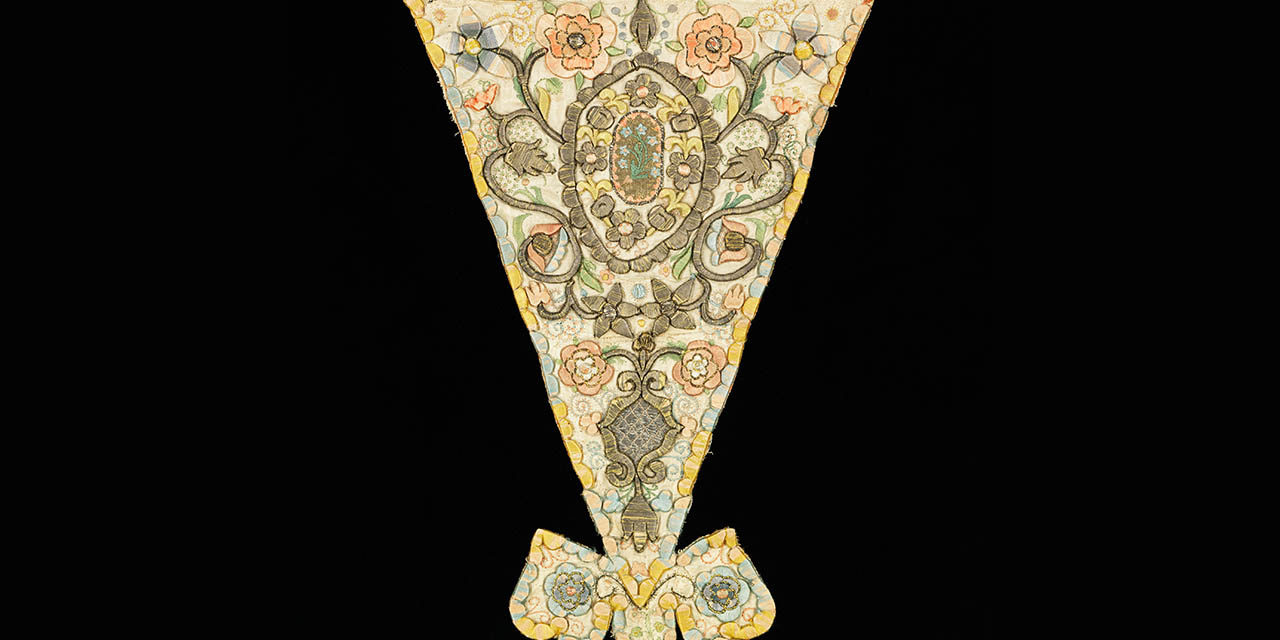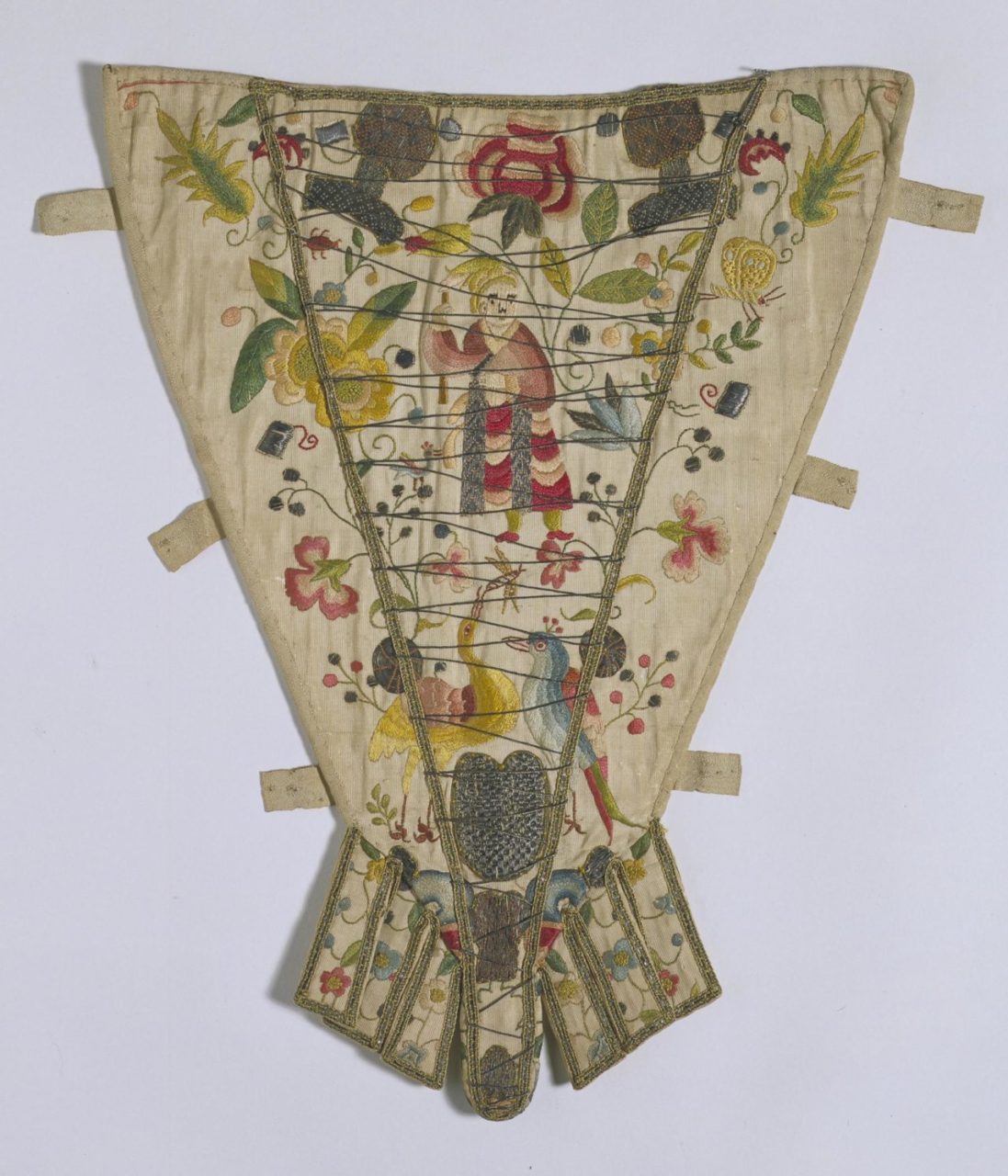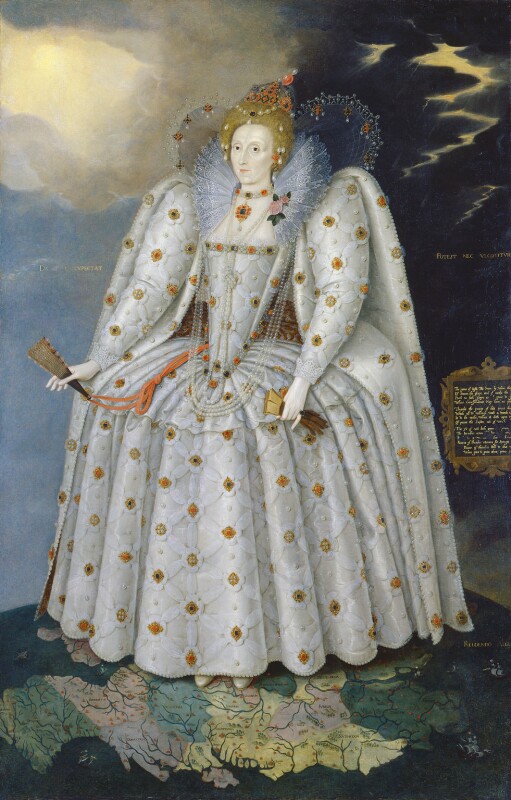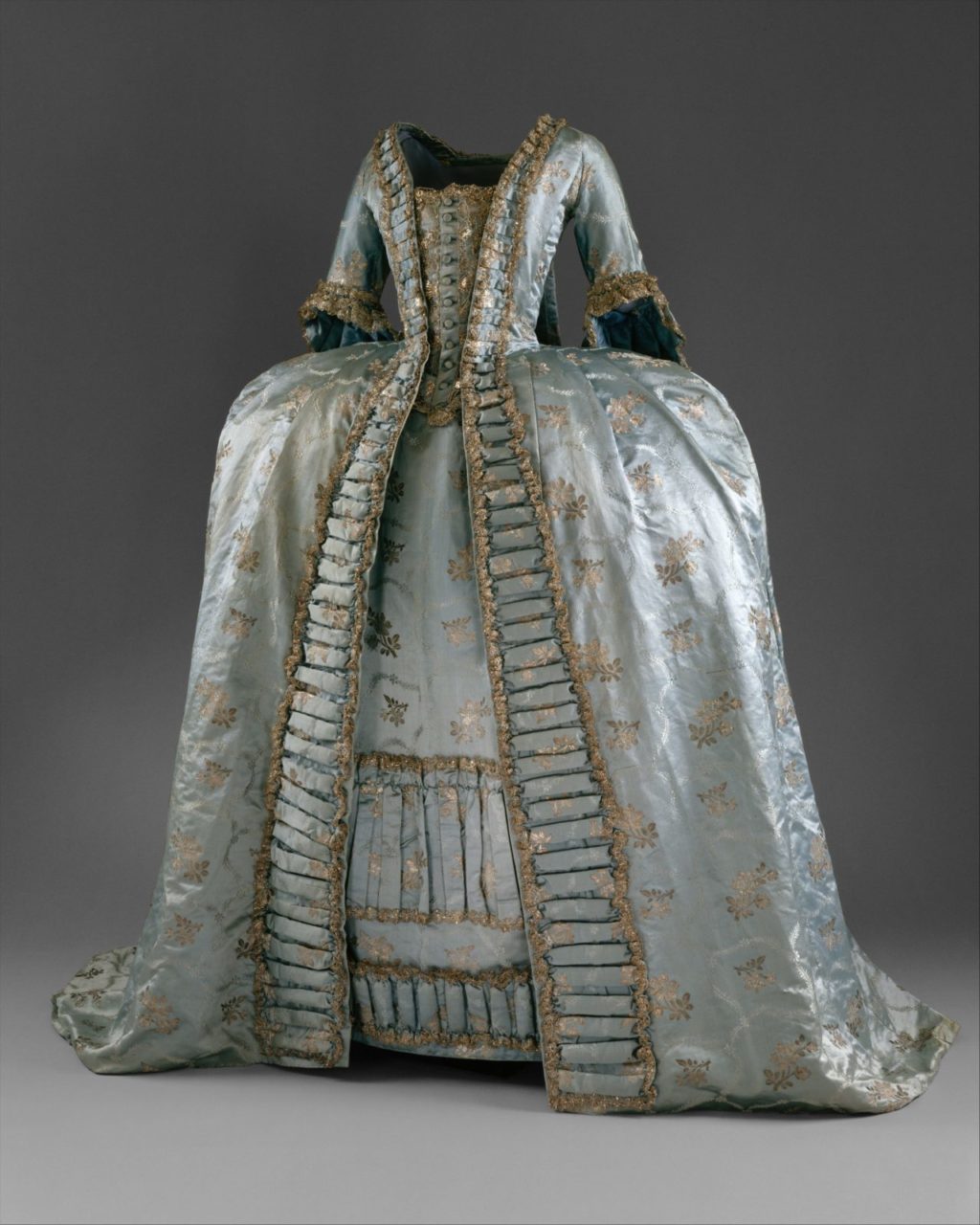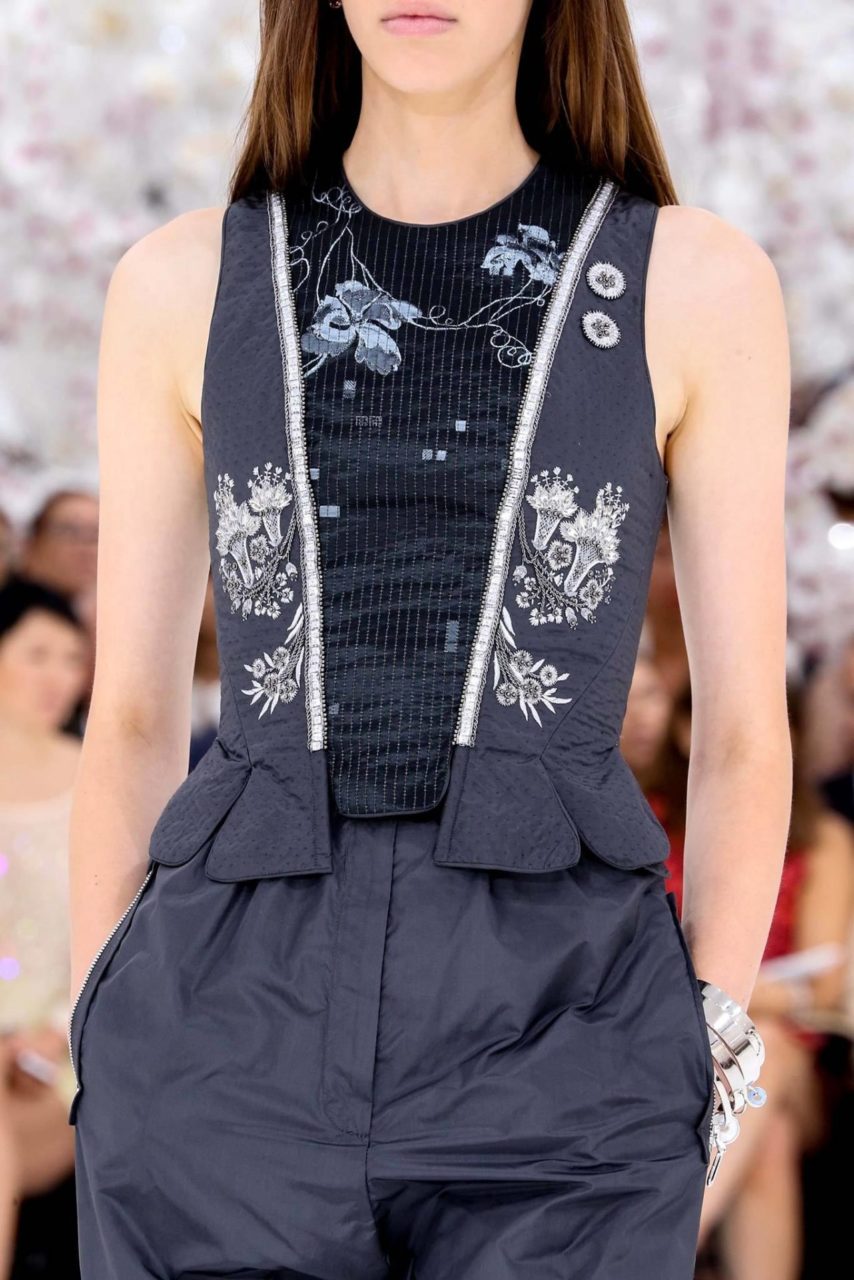A decorated triangular-shaped panel that fills in the front opening of a women’s gown or bodice during the late 15th century to the late 18th century.
The Details
A stomacher was a component of women’s costume worn throughout three centuries (Fig. 1). We get a clear glimpse of how a stomacher functions on the body in the Portrait of Maria Josefa de Lorena (Fig 2), where it is painted in a contrasting gold to the Archduchess’ blue gown
Susan Vincent, a researcher at the Centre for Renaissance and Early Modern Studies at the University of York, describes stomachers in Dressing the Elite: Clothes in Early Modern England (2003):
“[b]odices that did fasten down the front would generally be worn with a stomacher. This was a stiffened triangular insert worn point down, and fastened to the bodice at either side by points, pins or ribbon ties. Functionally, the stomacher filled in the gap between the two front edges of the bodice and continued the corseting effect. Visually, the highly decorated insert took the eye from the top down to its long bottom point, making the torso appear even longer.”
An example of this is figure 3, a surviving stomacher in the Victoria and Albert Museum’s collection, that features an elongating V-shape and non-functional lacing of silver braid down the front.
Another surviving stomacher in the V&A’s collection (Fig. 4) is richly embroidered with colored silks in designs of flowers and other natural motifs, just as Nathalie Rothstein, the Curator of Silks at the V&A, describes in Four Hundred Years of Fashion (1984): “It was often embroidered or decoratively trimmed.” (175)
Fig. 1 - Designer unknown (European). Stomacher, 1750-1775. Silk, metal, paper, linen. New York: The Metropolitan Museum of Art, 2009.300.1750. Brooklyn Museum Costume Collection at The Metropolitan Museum of Art, Gift of the Brooklyn Museum, 2009; Gift of Pratt Institute, 1934. Source: The Metropolitan Museum of Art
Fig. 2 - Anton Raphael Mengs (German, 1728-1779). Portrait of Maria Josefa de Lorena, Archduchess of Austria, ca. 1767. Oil on canvas; 128 x 98 cm. Madrid: Museo del Prado, P002186. Source: Museo del Prado
Fig. 3 - Designer unknown (British). Stomacher of ribbed silk and embroidered with colored silks, ca. 1740. Silk, whalebone, lined with silk, embroidered with coloured silks and trimmed with silver braid; (13.5 x 10.75 in). London: Victoria and Albert Museum, T.99-1962. Given by Mrs W. T. Alderson. Source: Victoria and Albert Museum
Fig. 4 - Designer unknown (British). Silk stomacher with polychrome embroidery, ca. 1710-ca. 1720. Silk. London: Victoria and Albert Museum, 311-1900. Source: Victoria and Albert Museum
Professors of history Phyllis Tortora and Keith Eubank describe components for women’s costumes, including stomachers in Survey of Historic Costume (2015):
“Gowns, open at center front, served as one of several layers. The outer layer was worn over an underbodice, a boned, stiffened garment like a corset that had a long, U-shaped section called a stomacher at the front: this filled in the upper part of the gown.” (213)
Sara and Tom Pendergast further describe stomachers in Fashion Costume and Culture: Clothing, Headwear, Body Decorations and Footwear Through the Ages (2003):
“The Stomacher was an essential part of women’s gowns, from about 1570 to 1770. In its most basic form it was a long V- or U-shaped panel that decorated the front of a woman’s bodice, extending from her neck-line down to her waist, … the stomacher could either be part of the bodice or a separate garment that fastened to the bodice with ties. The stomacher had two main purposes: to add decoration and to provide structure.” (524, 525)
As mentioned above, the stomacher is a part of the gown in this portrait of Elizabeth I (Fig. 5), but a separate piece in this robe à la française (Fig. 6), which the Met describes as “worn open down the front, revealing a (separate) petticoat and stomacher.” The V&A Museum also mentions that “stomachers could be made of material matching” (Figs. 5 & 6) or “contrasting with the gown and petticoat” (Fig. 1).
Fig. 5 - Marcus Gheeraerts the Younger (Belgian, 1561/62-1636). The Ditchley Portrait, ca. 1592. Oil on canvas; (95 x 60 in). London: National Portrait Gallery, NPG 2561. Bequeathed by Harold Lee-Dillon, 17th Viscount Dillon, 1932. Source: National Portrait Gallery
Fig. 6 - Designer unknown (European). Robe à la française, ca. 1765. Silk. New York: The Metropolitan Museum of Art, 2001.472a, b. Purchase, Irene Lewisohn Bequest, 2001. Source: The Metropolitan Museum of Art
Its Afterlife
Though inspired by different periods, Aquilano Rimondi’s Fall 2012 ready-to-wear collection (Figs. 7 & 8), and Christian Dior’s Fall 2014 Couture line (Figs. 9 & 10) both showed strong inspiration of women’s costume during the Renaissance and Rococo periods, including stomachers.
Fig. 7 - Tommaso Aquilano and Roberto Rimondi for Aquilano.Rimondi (Italian). Ready-to-wear dress, Fall 2012. Model: Daiane Conterato. Photograph by Marcus Tondo / InDigital | GoRunway. Source: Vogue
Fig. 8 - Tommaso Aquilano and Roberto Rimondi for Aquilano.Rimondi (Italian). Ready-to-wear dress, Fall 2012. Model: Ming Xi. Photograph by Marcus Tondo / InDigital | GoRunway. Source: Vogue
Fig. 9 - Raf Simons for Christian Dior (Belgian, 1968-). Couture, Fall 2014. Model: Agne Konciute. Photograph by Kim Weston Arnold / Indigitalimages.com. Source: Vogue
Fig. 10 - Raf Simons for Christian Dior (Belgian, 1968-). Couture, Fall 2014. Model: Georgia Hilmer. Photograph by Kim Weston Arnold / Indigitalimages.com. Source: Vogue
References:
- Four Hundred Years of Fashion. Edited by Natalie Rothstein, Madeleine Ginsburg, Avril Hart, Valerie D. Mendes, and Philip Barnard. London: V & A Publications, 1984. http://www.worldcat.org/oclc/828584696.
- Pendergast, Sara, Tom Pendergast, and Sarah Hermsen. Fashion, Costume, and Culture: Clothing, Headwear, Body Decorations, and Footwear through the Ages. Detroit: UXL, 2003. http://www.worldcat.org/oclc/1033461926.
- The Met. Robe à la Française. Accessed October 27, 2018. https://www.metmuseum.org/art/collection/search/83094
- Tortora, Phyllis G., and Sara B. Marcketti. Survey of Historic Costume. Sixth edition. New York, NY: Fairchild Books, 2015. http://www.worldcat.org/oclc/910929404.Victoria, and Albert Museum.
- V&A. Stomacher. Accessed October 27, 2018. http://collections.vam.ac.uk/item/O15322/stomacher-unknown/
- Vincent, Susan. “Fashioning Appearances.” In Dressing the Elite: Dressing the Elite Clothes in Early Modern England, 13–46. Oxford: Berg, 2003. Accessed September 27, 2018. http://dx.doi.org/10.2752/9781847889003/DRSELITE00010006.

